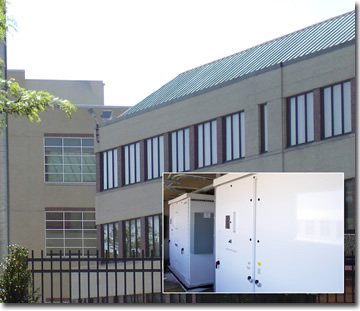Back Issues
|
 |
|
The project involves more than 23,000 proprietary 72-watt, 2-foot-by-4-foot thin-film solar panels from First Solar Inc. of Arizona. The panels are on fixed mounts on tracks with a minimum of rooftop penetrations. |
The photovoltaic solar power system at pharmaceutical company Schering-Plough's Summit, New Jersey, campus may be a 1.7-megawatt project, but in many ways, it is seven installations on seven separate rooftops that are interconnected.
"The unique part about this project is that it's built on the rooftops of seven buildings like a school campus, so as we complete one, we can bring that building on-line," says Steve Gabrielle, director of renewable energy for Allentown, Pennsylvania-based PPL Renewable Energy.
"Every building had to have its own permit, like seven individual projects. But the township and mayor, from day one, were very helpful throughout the process."
Collectively, the seven installations will generate about three percent of the energy the Summit campus uses annually, says Tom Pagliuco, Schering-Plough director of energy, who is based in Summit. Despite its size, he says the project is just one piece in the company's overall energy efficiency plan.
So far, Schering-Plough has completed about two dozen projects that have reduced its energy use by 17 percent.
"We have an energy usage strategy, and we have a game plan on how we want to achieve it," Pagliuco says. "Number one is energy efficiency. The cheapest kilowatt is the one you don't use."
This past March, the Environmental Protection Agency named Schering-Plough a 2009 Energy Star Partner of the Year for outstanding energy management and reductions in greenhouse gas emissions.
In addition, Schering-Plough's plant in Cleveland, Tennessee, recently earned an Energy Star from the EPA for ranking in the top 25 percent of energy performance nationwide. The Cleveland facility uses an average of 35 percent less energy than similar pharmaceutical plants across the country.
Regardless of the project, Pagliuco says the company looks to see if it meets three key tests: It has to be sustainable, be good for society, and make good business sense.
"Hopefully, it will do the right thing for the environment, and in this case, solar also helps society," Pagliuco says. "By working with PPL, we were able to put together a program that was a great deal for us and made business sense."
 |
|
Under an agreement with Schering-Plough, PPL Renewable Energy financed, designed, built, and will operate, the solar power system. PPL's marketing arm will receive the federal tax credit and the solar renewable energy certificate associated with the project. |
Under the agreement, PPL Renewable Energy financed, designed, built, and will operate the PV system. PPL Corp.'s marketing arm, PPL Energy Plus, will receive the federal tax credit and the solar renewable energy certificates (SRECs) associated with the project.
In return, Schering-Plough receives a long-term power contract from PPL that features attractive electricity rates.
Each time a megawatt hour is generated, an SREC is issued. Under a new program developed by the New Jersey Board of Public Utilities, projects that are grid connected no longer receive state tax rebates.
Instead, SRECs, which carry a higher price cap than they did when the rebates were in place, are issued and can be traded or sold in a state-managed market. With the recent credit crunch, fewer projects are being built, Gabrielle says. That, in turn, has created a tighter market for SRECs and boosted their price.
The New Jersey Board of Public Utilities has also eliminated size limits on solar projects, and Gabrielle believes that will stimulate larger projects in the future.
Work on the project began more than two years ago when PPL Renewable Energy and Schering-Plough began evaluating the pharmaceutical company's five northern New Jersey campuses for potential solar projects.
Among the criteria examined were rooftop age, combined rooftop square footage, rooftop shading, and whether equipment, such as ventilation, was mounted on the roofs, Gabrielle says.
"The newest rooftops were the key," he says. "If you're going with solar panels that are set for 20 to 25 years, you want roofs that are new and under warranty."
The Summit campus proved to have the largest expanse of fairly new, flat, wide-open roofs with little, if any, shading.
When the project was being considered two years ago, New Jersey had a cap of 2 MW on large commercial projects to qualify for rebates. That's one reason why the project was sized at 1.7 MW, Gabrielle says. Since then, the limits have been removed, so he says he expects larger projects will begin to be built in the state.
PPL Renewable Energy offers a menu of services, Gabrielle says. In this case, Schering-Plough opted for the full-service plan, which includes design, construction, and operation.
Because of past relationships with PPL-including a co-generation plant that PPL designed, built, and operates-Pagliuco says Schering-Plough felt comfortable working with the Allentown firm.
"Both companies (PPL and First Solar) have been great to work with, and I think relationships have gone really well, and I think that is very important," he says. "You want a partner you can trust."
 |
|
The installations on each of the seven rooftops was individually engineered, designed, and permitted. As one rooftop was completed, it would be brought online, and the crew would move on to the next rooftop. |
The project involves more than 23,000 proprietary 72-watt, 2-foot-by-4-foot thin-film solar panels from First Solar Inc. of Tempe, Arizona, says company spokeswoman Lisa Morse. "This technology is very different because it's using just a thin film of semi-conductor between two pieces of glass."
The panels are on fixed mounts on tracks with a minimum of rooftop penetrations.
The project also involved 10 to 14 inverters. Of those, all but a couple were from Satcon Technology Corp. The remainder were from Xantrex Technology Inc.
In addition, First Solar looks at the carbon footprint of the panels from material sourcing through the end of their lives. The purchase price already includes a recycling fee. Once the panels are past their useful life, owners simply call the company or visit First Solar's Web site, and they receive instructions about how to return the panels for recycling.
First Solar also has hit a milestone and now can manufacture panels for less than $1 per watt.
"That's really been a high point in the industry for the last 20 to 30 years," Morse says. "We're striving to get the cost down to between 60 and 65 cents. Once we hit that price point, that's where it's cost comparable. There's no difference from conventional electricity and solar electricity."
Depending on the project, First Solar simply offers panels or will go all the way, doing the engineering, procurement and construction. Having all of those services under one roof was a large selling point for the Schering-Plough project, Gabrielle says.
One of the biggest challenges with the project was finding enough contractors that could meet Schering-Plough's stringent security requirements at its campuses. Only two, which had done previous work for the pharmaceutical manufacturer, met the requirements.
Construction began during the summer of 2008 and was completed by year's end. When the project was initially designed, it appeared that Congress wouldn't renew the federal energy tax credit. For a project to qualify, it had to come on line before Dec. 31, 2008.
With Congress renewing the credit, Gabrielle says they had a bit more breathing room and could lengthen the construction period slightly. Nasty weather during the winter also prompted small delays.
Construction started on the largest rooftop and moved down to the smallest ones.
The installation on each of the seven rooftops was individually engineered, designed, and permitted. As one rooftop was completed, it was brought online, and the crew would move on to the next one. The project was fully online by the end of April.
Gabrielle says it's too early to tell whether the PV panels are generating electricity as rated, but based on data from installations in Germany and elsewhere, he has no cause to think they won't perform well.
The solar system is expected to reduce Schering-Plough's carbon production by 1.3 million pounds annually.
Although the solar system is one piece of the company's overall energy program, Pagliuco says it has gained the most attention because of its size and visibility.
Coworkers have contacted Pagliuco to inquire about the project, and he uses it as an entry point to work in the message about energy efficiency.
"It serves as a rallying point because people are very cognizant and very in tune with the renewable efforts," he says. "Energy efficiency doesn't have the sex appeal that renewables do."
He also envisions it as a way to educate the community and local school children about solar power and energy efficiency in general.
The company plans to develop a "green room" where school children can come and learn about solar generation and energy efficiency. Students also will be able to see real-time power output via a dedicated Web page.
"I can envision a lot of science projects coming out of this-again, we're a science-based company," Pagliuco says. "You're seeing less and less kids going into science and math. Anything that promotes science and math, I'm generally in favor of."
Pagliuco says an added benefit of the system is it generates more power during the summer when the demand on the grid is the greatest.
The Summit campus is predominately office space and research and development, with most work done from 7 a.m. to 7 p.m., Monday through Friday.
Peak solar production will be between 1 and 2 p.m., which coincides with peak electricity demands, Pagliuco says.
In New Jersey, several utilities have peak usage surcharges from June 1 to Sept. 30.
"We'll be reducing our peak charges, and it will take some of the stress off the grid," he says. "But I think the full advantage will come into play during the summer."
Although the solar-generation system will reduce Schering electricity use by three percent, it will help reduce the company's peak summer use by 12 percent.
Pagliuco says he will monitor the system to determine whether similar projects elsewhere are viable.
"Definitely-we're looking at whatever makes sense," he says. One possible site is in Puerto Rico, which is beginning to develop solar incentives.
Schering-Plough also is looking at its European facilities. "They haven't really come to where a third party builds, owns, and operates the system," Pagliuco says. "In Spain, Italy, and Germany, I think we would look at it.
May/June 2009








